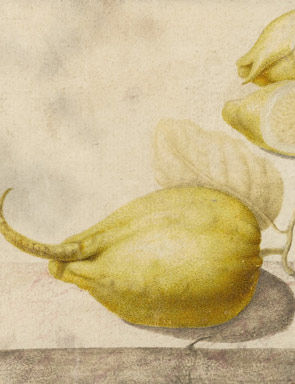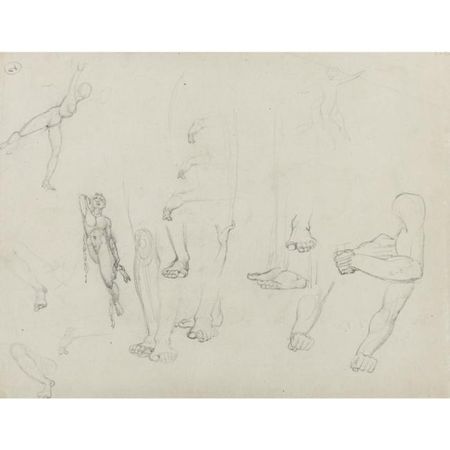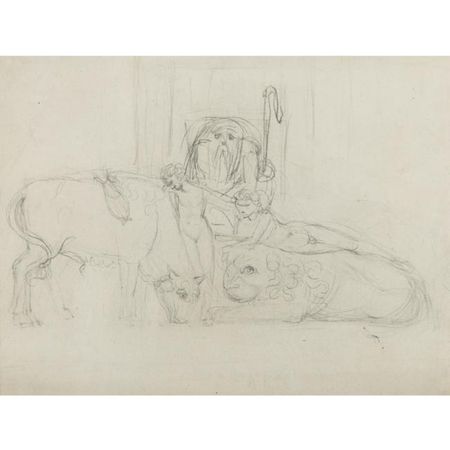Property from the Collection of Charles Ryskamp Exceeds High Estimate to Bring $1.6 Million
The top lot of the auction was the watercolor Lemon, attributed to Giovanna Garzoni, which soared to more than 10 times its pre-sale high estimate and achieved $62,500. Photo: Sotheby's.
NEW YORK, NY.- Old Masters Week opened today at Sotheby’s New York with the dedicated auction of Property from the Collection of Charles Ryskamp, which exceeded its high estimate in achieving $1,628,727 (est. $800,000/1.2 million*). Many bidders competed in the room and by phone for drawings, furniture and decorations from Mr. Ryskamp’s private residences in New York City and Princeton, New Jersey, which resulted in several works greatly surpassing their pre-sale estimates. Mr. Ryskamp served as Director of The Pierpont Morgan Library, now The Morgan Library & Museum, and the Frick Collection for a combined nearly 30 years, helping to make both institutions among the most prestigious museums in New York City. The works on offer today were sold for the primary benefit of Princeton University, where Mr. Ryskamp began his academic career.
“We are very pleased with the results of today’s auction of the collection of Charles Ryskamp, which exceeded our expectations,” commented Elaine Whitmire, Sotheby’s Vice Chairman. “Mr. Ryskamp played a prominent role in the New York art-world, and the buyers in today’s sale now hold a very personal piece of his unique aesthetic and passion for collecting.”
The top lot of the auction was the watercolor Lemon, attributed to Giovanna Garzoni, which soared to more than 10 times its pre-sale high estimate and achieved $62,500. Other works that greatly surpassed their estimates included Hendrik Hondius the Elder’s The Castle of Tervueren, which brought $50,000, and Edgar Degas’s Flowerpots, which more than doubled its estimate in selling for $50,000 as well. William Blake’s Sketches For America And Other Books And The Lion Lying Down With The Ox (Verso), an important double-sided sheet containing studies that relate to at least two of Blake's early literary projects, achieved $56,250. The work was purchased by a San Francisco dealer on behalf of collector Robert Essick.
Old Masters Week at Sotheby’ New York continues with sales through this Friday the 28th. A full calendar of the remaining auctions is below:
Old Masters Week 2011 – Calendar of Remaining Sales
Old Master Drawings, 26 January
Important Old Master & 19th Century Paintings from the Collection of Jacob Elie Safra; 26 January – 6:30pm
Important Old Master Paintings & Sculpture, 27 January
Old Master & 19th Century European Art, 28 January
*Pre-sale Estimates do not include buyer’s premium
Attributed to Giovanna Garzoni (Ascoli Piceno (?) 1600 - 1670 (?) Romre), lemon, Citrus limon (L.) Burm. f.: two twin -fingered lemons and two transverse sections of a third. Photo: Sotheby's
bears number 620 in pen and brown ink, center right, watercolor and bodycolor heightened with lead white, over black chalk, on vellum, 5 3/4 by 8 3/4 in. 14.5 by 22.1 cm - Estimate 3,000—5,000 USD. Lot Sold 62,500 USD PROVENANCE: Cassiano dal Pozzo EXHIBITED: Morgan 2001, no. 10 LITERATURE AND REFERENCES: D. Freedberg and Enrico Baldini, series editor, Series B: Natural History. Part One: Citrus Fruit, The Paper Museum of Cassiano dal Pozzo,1997, p. 251, no. 98, reproduced NOTE: Hybrid and misshapen fruits were of particular interest in the world of Cassiano. In this drawing, not reproduced in the Hesperides,1 three twin lemons with finger-shaped appendages are represented. These belong to a sizable group of such fruits recorded in the Museum Chartaceum. As David Freedberg points out, the importance of Cassiano' s natural history drawings cannot be overestimated. They were the earliest illustrations ever produced with the aid of a microscope and the first and most ambitious attempt to clarify the natural world through a visual description, made at the same time as other scientific investigations in astronomy, mathematics and physics. The pursuit of comprehensiveness and accuracy surpassed previous attempts, such as those of Aldovrandi or Gesner, eliminating what was not scientific and the result of imagination. About three thousand natural history drawings survive from Cassiano's Museum Chartaceum, the majority being in the Royal Library at Windsor Castle.2 The attribution to Giovanna Garzoni was proposed by Charles Ryskamp. See also lot 24. 1. Cassiano had been gathering material, both written and visual, about citrus fruits from all over Italy, and this he made available to Giovanni Battista Ferrari for his compendium of citrological treatises the Hesperides, published after many vicissitudes in 1646. Hendrik Hondius the Elder (Duffel 1573 - 1650 The Hague), The Castle of Tervueren. Photo: Sotheby's pen, brown ink and watercolor over black chalk on paper, 1/4 by 13 3/8 in 18.5 by 34 cm - Estimate 15,000—20,000 USD. Lot Sold 50,000 USD PROVENANCE: P. & D. Colnaghi, London, 1963 EXHIBITED: London, P. & D. Colnaghi, Exhibition of Old Master Drawings, July 2-26, 1963, no. 27 (as Jan Brueghel the Elder, A Castle in a Lake), plate iv LITERATURE AND REFERENCES: Sale, Sotheby's, London, July 7, 1966, under lot 31 (a drawing by Hendrik Hondius of the castle of Tervueren, and the note mentions the present drawing because of the subject) NOTE: The first castle at Tervueren, near Brussels, was built around 1200, and during the following centuries it was rebuilt and enlarged fairly regularly. After Archduke Albert and his wife Isabella became governors of the Spanish Netherlands in 1595, Tervueren became one of their favourite residences, and they soon restored it extensively. It is possible that this drawing, which Felice Stampfle considered the most topographically accurate of all the many depictions of the castle, was made not very long after this restoration; a drawing of the castle from a different viewpoint, signed by Hondius with his characteristic monogram and dated 1605, is at the Pierpont Morgan.1 The castle was depicted by many Flemish artists. The earliest notable image appears in the background of one of Barent van Orley's extraordinary series of tapestry designs, The Hunts of Maximilian, in the Louvre, which are usually dated circa 1525-30. From later in the 16th century, the known drawings include one sold as Hondius in 19662 and another version of the same drawing in Rotterdam, while further drawings in the Metropolitan Museum of Art, New York, and the Kupferstichkabinett, Berlin, as well as the Morgan drawing already mentioned, seem to date from shortly after 1600. The same is true of a 1608 drawing by Denijs van Alsloot, at the Ecole des Beaux-Art, Paris, which incorporates a view of the castle in the background of one of the artist's characteristic forest landscapes. Finally, the Allegory of Taste in the Prado, painted in 1618 by Peter Paul Rubens and Jan Brueghel, includes a clear view of Tervueren in the background.3 Of all these, by far the closest in style to the present drawing is the signed view of the castle by Hondius at the Morgan Library. There, we see very much the same careful penwork, fine parallel hatchings, delicate, looping foliage and range of color, and in both drawings there are also small areas where the artist has made extremely similar slight indications of architecture or trees in black chalk, which were ultimately not developed or completed in the final drawing, but which were also not erased. When Felice Stampfle wrote her magnificent Morgan catalogue, published in 1991, in which the Hondius drawing is so thoroughly described, she had not seen the present drawing in the original, and therefore mentioned it only on the basis of the 1963 Colnaghi's catalogue, illustration and attribu Edgar Degas (1834 - 1917), Flowerpots. Photo: Sotheby's oil on paper laid down on canvas, 5 1/2 by 4 3/4 in. (14 by 12 cm) - Estimate 12,000—18,000 USD. Lot Sold 50,000 USD Galerie Brame & Lorenceau has confirmed the authenticity of this work. This oil will be reproduced in the Second Supplément to the Catalogue raisonné of Degas's works being prepared by Brame & Lorenceau. PROVENANCE: L. Henri Fèvre (the artist's nephew, according to inscription on stretcher) EXHIBITED: Morgan 2001, no. 107 William Blake (1757 - 1827), Sketches for America and Other Books and The Lion Lying Down with the Ox (verso). Photo: Sotheby's later numbered C 2 upper right and further numbered 2 upper left and 2 on reverse, pencil on wove paper, a double-sided drawing, 7 7/8 by 10 3/8 in. 20 by 26.3 cm - Estimate 30,000—50,000 USD. Lot Sold 56,250 USD PROVENANCE: W.A. White, 1905 EXHIBITED: New York, Grolier Club, Books, Engravings, Water-Colours & Sketches by William Blake, January-February, 1905, no. 106 LITERATURE AND REFERENCES: Geoffrey Keynes, Drawings of William Blake, 92 Pencil Studies, 1970, nos. 16 and 5 NOTE: The present work is an important double-sided sheet containing studies that relate to at least two of William Blake's early literary projects. The sketches on the recto have been dated to 1793 and are connected to Blake's book, America, A Prophesy, a work that celebrated America's 'liberal' society in comparison to what Blake saw at Britain's 'repressive' society. The drawing on the verso, dates from circa 1790-5 and relates to various other works including America and in a more general sense the Pastoral Scene (British Museum) where a boy is depicted lying down on a ram.
By descent to his brother, Carlo Antonio dal Pozzo
By descent to his son, Gabriele dal Pozzo
By descent to his son, Cosimo Antonio dal Pozzo
By whom sold in 1703 to Pope Clement XI
Thence by descent to Cardinal Alessandro Albani
From whom acquired in 1762 by James Adam for King George III
Thereafter, Royal Library, Windsor Castle, until after the first World War, when several albums of dal Pozzo drawings were sold
Jacob Mendelson, London
Hazlitt, Gooden & Fox, London
Niall Hobhouse, Ltd., London (as Italian artist, circa 1630)
Acquired from the above, 1987
2. For an account of the whereabouts of the drawings, see D. Freedberg and Enrico Baldini, op. cit., 1997, p. 35
W.R. Jeudwine, London
Alice Tully, New York
By whom gifted, 1994
Morgan 2001, no. 2
Paris, Institut Néerlandais, et al., Rubens and Rembrandt in Their Century: Flemish and Dutch Drawings of the 17th Century from the Pierpont Morgan Library, 1979-80, under no. 6
F. Stampfle, Netherlandish Drawings of the Fifteenth and Sixteenth Centuries and Flemish Drawings of the Seventeenth and Eighteenth Centuries, 1991, p. 47, under no. 77, illus. fig. 59
E. Haverkamp-Begemann, et al., The Robert Lehman Collection, VII, Fifteenth- to Eighteenth-Century European Drawings, 1999, p.150, under no. 35; p.152, note 17
S. van Sprang, 'A propos de quelques dessins de Denijs van Alsloot,' in Delineavit et Sculpsit, 26, November 2003, pp. 11-18, illus. fig. 5 (as Denijs van Alsloot)
Marcel Guerin (according to Neal Fiertag)
Eric G. Carlson, New York
Yale 2010, no. 62
Dr. A.S.W. Rosenbach, New York, 1939
Mrs. Gerard B. Lambert, Princeton, New Jersey
By whom gifted to Charles Ryskamp, 1969
Philadelphia, Philadelphia Museum of Art, Works of William Blake Selected from Collections in the United States, 1939, no. 194
Princeton, Princeton University Library, William Blake, Engraver, December 1969 - February 1970, no. 24
New York, Grolier Club, William Blake and his Followers, March-June, 1974 (unnumbered)
New York, Salander-O'Reilly Galleries, William Blake, Paintings, Watercolors, Drawings Exhibition, November-December, 1992, no. 8988
Morgan 2001, no. 48
Yale 2010, no. 193
David Bindman, Blake as an Artist, 1977, p. 47
Martin Butlin, The Paintings and Drawings of William Blake, 1981, no. 226, pls. 259-60

/https%3A%2F%2Fprofilepics.canalblog.com%2Fprofilepics%2F1%2F0%2F100183.jpg)
/https%3A%2F%2Fstorage.canalblog.com%2F03%2F02%2F119589%2F96711876_o.jpg)
/https%3A%2F%2Fstorage.canalblog.com%2F11%2F31%2F119589%2F94773502_o.jpg)
/https%3A%2F%2Fstorage.canalblog.com%2F20%2F83%2F119589%2F94772815_o.jpg)
/https%3A%2F%2Fstorage.canalblog.com%2F26%2F72%2F119589%2F75604929_o.jpg)
/https%3A%2F%2Fstorage.canalblog.com%2F59%2F60%2F119589%2F26458628_o.jpg)








/http%3A%2F%2Fstorage.canalblog.com%2F47%2F98%2F119589%2F129092601_o.jpg)
/http%3A%2F%2Fstorage.canalblog.com%2F84%2F73%2F119589%2F128782095_o.jpeg)
/http%3A%2F%2Fstorage.canalblog.com%2F36%2F16%2F119589%2F127992333_o.jpg)
/http%3A%2F%2Fstorage.canalblog.com%2F10%2F81%2F119589%2F127170196_o.jpg)